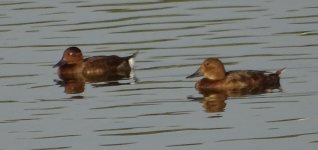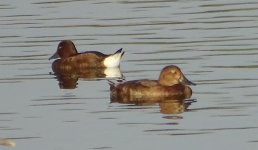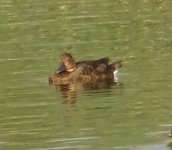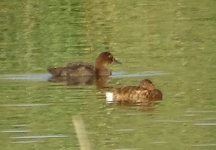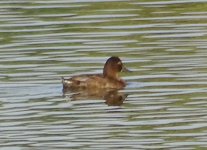-
Welcome to BirdForum, the internet's largest birding community with thousands of members from all over the world. The forums are dedicated to wild birds, birding, binoculars and equipment and all that goes with it.
Please register for an account to take part in the discussions in the forum, post your pictures in the gallery and more.
You are using an out of date browser. It may not display this or other websites correctly.
You should upgrade or use an alternative browser.
You should upgrade or use an alternative browser.
Ferruginous ducks? Near Madrid (1 Viewer)
- Thread starter testoduro
- Start date
More options
Who Replied?Deb Burhinus
Used to be well known! 😎

Yes all Fudge - You have a mixture here of male, male in eclipse, female and female/juvenile type but hard on these images to be certain of separating the latter. All those with pale eyes are male.
Deb Burhinus
Used to be well known! 😎

testoduro - please don’t misunderstand my post - I meant that from the photos, as they are not very clear,, it is difficult to tell if the female type birds are juveniles or adult females ie so called ‘female/juvenile type’ so this alone can not be proof of breeding but you definitely have both sexes or juveniles there, so ‘hopefully’!
Last edited:
testoduro - please don’t misunderstand my post - I meant that from the photos, as they are not very clear,, it is difficult to tell if the female type birds are juveniles or adult females ie so called ‘female/juvenile type’ so this alone can not be proof of breeding but you definitely have both sexes or juveniles there, so ‘hopefully’!
Yes, Deb. You're right. I should have added It would be fantastic news...
Do you think we can at least certify for sure that there are more than two different specimens?
Last edited:
Yes, Deb. You're right. I should have added It would be fantastic news...
Do you think we can at least certify for sure that there are more than two different specimens?
What is the (precise) location? ...In case I ever go back to Madrid
What is the (precise) location? ...In case I ever go back to Madrid
Laguna de Miralrío en Velilla de San Antonio.
https://ebird.org/hotspot/L4865496?yr=all&m=&rank=mrec
Laguna de Miralrío en Velilla de San Antonio.
https://ebird.org/hotspot/L4865496?yr=all&m=&rank=mrec
Great thanks. Loads of good things there I see: red-necked nightjar, citril finch etc
Great thanks. Loads of good things there I see: red-necked nightjar, citril finch etc
An old abandoned quarry. A spectacular birding spot.
An old abandoned quarry. A spectacular birding spot.
Is there info about access etc anywhere?
...If there's a website we could add a link to opus. I can see there's public transport to the general area but I remember from experience it's good to have specific details about how/where to go.
lou salomon
the birdonist
apart from that adult male ferruginous duck i only see female type common pochards..:-C
stevethehydra
Well-known member
The right hand bird in pics 1-2 looks like a female Common Pochard (or possibly CP x Ferruginous hybrid) to me. I don't think it can be a pure Ferruginous on head/bill shape.
edit: cross-posted with Lou!
edit: cross-posted with Lou!
The right hand bird in pics 1-2 looks like a female Common Pochard (or possibly CP x Ferruginous hybrid) to me. I don't think it can be a pure Ferruginous on head/bill shape.
edit: cross-posted with Lou!
So the only clear FDs are the left-hand males in pics 1 and 2, am I right? The rest are pochards... (or hybrids)
Last edited:
Deb Burhinus
Used to be well known! 😎

So the only clear FDs are the left-hand males in pics 1 and 2, am I right? The rest are pochards... (or hybrids)
Apologies for not scrutinising these more closely, I’m trying to look at these on a mobile device (at work!) Despite what Lou says, I see more than one Fudge duck here (I understood these to be all separate birds?)the bird at rest in pic 4 for example, has a clearly defined white undertail covert patch as does the left hand bird in image 2, but maybe my eyes are failing me here and there is only one Fudge duck in the series of images :-C
Just to add a note about head shape from a BB article which you may find helpful to help identify all these yourself:
on head shape, Ferruginous ducks have
“...a noticeably domed head shape since the dome is produced by elongated feathering, its exact position varies. When relaxed, the dome is central, peaking just behind the eye ..., but at other times the peak is farther towards the rear ... and the head shape is then more similar to that of a Common Pochard. When the bird dives, the crown feathers may be flattened, so that the head looks more rounded. Occasionally, it may show the effect of a slight ‘bump’ at the rear of the crown. Juveniles and first-winters show rounder heads than do adults in full plumage ... and eclipse adults, particularly females, may look smilaly round-headed since their head feath- ering is shorter ..., while males may look round-headed when in moult.”
And on undertail coverts
“UNDERTAIL-COVERTS The most character- istic and oft-quoted feature is the Ferrugi- nous Duck’s large white undertail-covert patch.” ... etc p7
As for identifying hybrids, its a minefield ...
https://britishbirds.co.uk/wp-content/uploads/article_files/V93/V93_N01/V93_N01_P004_021_A002.pdf
Last edited:
Joern Lehmhus
Well-known member
I´d only identify the male in photo 1 and 2 as a ferruginous. With the others I would be carefull with a safe ID concenring the photo quality (no offence meant) The front bird in photo 4 could be a female ferruginous or a hybrid , certainly not common pochard. other birds are less clear, but from these photos seem to have pochard genes. Please not pochard x ferruginous are fertile, and hybrid s could backcross with either parent species or among themselves.
Deb Burhinus
Used to be well known! 😎

Thank you Joern - I hoped you would find time to comment (even though it confirms only what I already knew, Anas identification is well beyond me :-O)
Thank you Joern - I hoped you would find time to comment (even though it confirms only what I already knew, Anas identification is well beyond me :-O)
Aythya even!
Deb Burhinus
Used to be well known! 😎

Last edited:
Nutcracker
Stop Brexit!
Deb Burhinus
Used to be well known! 😎

You have to be an Aythyist to cope with them.
:king:
... or just Fudge the Ansers like I do and leave the Duck alone o
Users who are viewing this thread
Total: 2 (members: 0, guests: 2)




